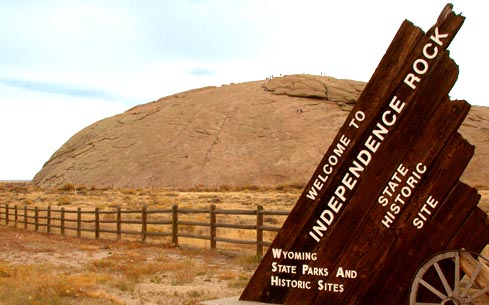 Emigrants to Oregon in the 1840s knew that if they reached Independence Rock (located in what is now central Wyoming) by Independence Day, they had a good chance of beating the snows in the Western mountains.
Emigrants to Oregon in the 1840s knew that if they reached Independence Rock (located in what is now central Wyoming) by Independence Day, they had a good chance of beating the snows in the Western mountains.
Independence Rock, 800 miles from the Missouri River, was a huge landmark along the Oregon Trail. Most emigrants were impressed with its mass, though some found it unremarkable.
Independence Rock was not only a landmark, but a calling card, a register of those who had made it that far on the journey. Many travelers painted their names on the rock, and later wayfarers searched for the names of people they knew:
On the side of the rock names, dates and messages, written in buffalo-grease and powder, are read and re-read with as much eagerness as if they were letters … from long absent friends … being a place of advertisement, or kind of trappers’ post office…” William Marshall Anderson, 1834
“It is the great register of the desert; the names of all the travelers who have passed by are there to be read, written in coarse characters; mine figures among them.” Fr. Pierre-Jean DeSmet, June 14, 1840
“…found inscribed on its eternal sides the names of many of the company who passed by in the first emigration, besides many others, doubtless of mountaineers and trappers.” Samuel Hancock, 1845
“It was covered with names of the passing emigrants, some of whom seemed determined, judging from the size of their inscriptions, that they would go down to posterity in all their fair proportions.” Howard Stansbury, July 31, 1849
My favorite story of Independence Rock tells of a cannon hauled to the top of this monument on July 4, 1847, and shot off in honor of our nation’s birthday. At least two people present there that day later recounted the event:
On Independence day this party fired a cannon from the top of the rock, and planted a flag there.” Robert Caufield, July 4, 1847
“We passed Independence Rock, on Sweetwater, on the 4th day of July, and hoisted the Stars and Stripes and fired the cannon on top of said rock at 12 o’clock that day.” Hon. Ralph A. Geer (who traveled the Oregon Trail as a boy in 1847, and described the day in a speech many years later).
I included this story in my novel, which is set in 1847. To me, it shows the sense of adventure and pluck – some might call it folly – of our 19th century ancestors.
What do you think – was it adventure or folly?
